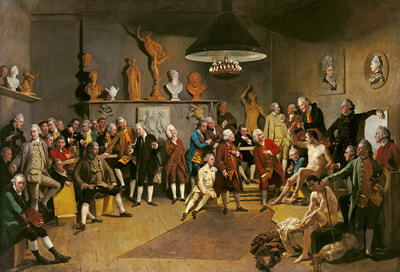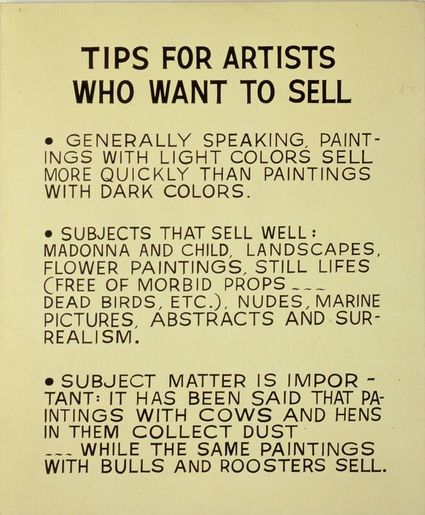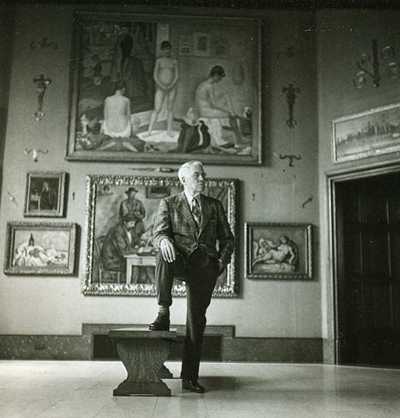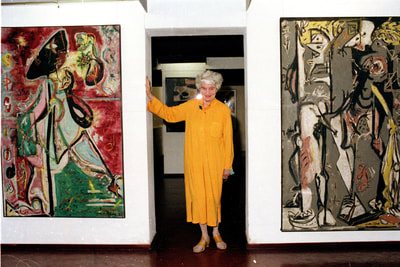TC#8The value of art can be measured in different ways - personal, cultural, social, economic, political, and so on. Works of art and artists are not equally valued. Artists can be marginalised because of prevailing social attitudes. Attitudes to art change over time.
About the graphicOur Threshold Concepts for Art are accompanied with illustrations to aid their introduction. Each image contains a reoccurring graphic: a fingerprint in the shape of an artist's palette. Here, the palette is both a prized art object sitting proudly on top of a plinth made of coins and also appears jammed into a red recycling bin. Ideas from one generation tend to reappear, slightly transformed, in the next. How do we measure the value of art and artists? Both the plinth and the bin look slightly precarious on a floor with a spreading crack reminiscent of Doris Salcedo's Shibboleth.
|
"Prices of Van Gogh's works at sales in 1987, in particular, stunned the world: His Irises sold for $53.9 million and Sunflowers for $39.9 million [...] The irony was grotesque in light of the artist's own poverty and despair over being unable to sell works during his lifetime."
CYNTHIA FREELAND
How might the artworks above connect to TC#2? Follow the links to find out more. Consider not only how works of art might be valued in different ways, but also how artists have reflected upon and responded to perceptions of value within art.
WhAT DO I NEED TO KNOW?
- The concept of the value of art has a long history. Value can be measured in so many different ways - social, economic, spiritual, therapeutic, political...etc. Before the existence of an art market, works of art tended to have a more symbolic or spiritual significance to the communities that made them. Now it's really difficult to separate in our minds the notion of value from money, especially when works of art can be bought and sold for huge sums of money. Some works of art are so precious that we use the term "priceless" to describe them. John Berger, in his celebrated BBC series from the 1970s 'Ways of Seeing', spends an entire episode discussing the relationship between European oil painting, wealth, property, power and value. It might seem a bit old fashioned now, but Berger's arguments were revolutionary at the time.
- We sometimes refer to the history of art. It might be more helpful to consider the idea of histories of art. Some writers also refer to the herstory of art, to indicate the extent to which women have been deliberately written out of history. Similarly problematic is the notion of a canon of great artists and art works. Art has a number of histories in which the relative value of artists and art works is contested.
- Certain types of art can be considered more valuable than others. For example, a distinction is often made between art, craft and design. Craft and design objects may have a particular use (as well as being beautiful) and this might affect their status and value. We find a range of attitudes to the relative status of art, craft and design across the world. This often relates to dominant traditions, prevailing philosophical ideas, religious affiliations, the availability of raw materials and the political climate.
- The value of the arts (as a whole) is often debated within the context of politics and education. National galleries of art are funded by taxpayers' money. The work they collect and put on display for the public, in theory, owned by the nation. Regional arts organisations have to compete for limited funds with larger, metropolitan institutions. The extent to which the arts are supported in the education system is connected to perceptions of their value (to the individual, to the economy, to society as a whole). Are the arts intrinsically or extrinsically valuable?
- Some galleries, like Tate Modern, have decided to abandon the chronological display of works of art in favour of a thematic approach. They have also attempted to address the under-representation of women artists and art from across the world. 50% of the artists on display at Tate Modern are now female. Consequently, galleries like Tate can have an enormous impact on the writing of art history, the public's attitude to art and the financial value of art in the market place. The institutions in which we see works of art shape our sense of their value.
Below is an introductory slideshow to encourage initial reflections and discussion:
Practical ideas for the classroom
- Crowdsource a list of the qualities you think a work of art should have to guarantee its value. For example, you may want to include terms like skill, beauty, relevance, emotionally engaging etc. Now, print out a fairly random selection of works of art. Try to include a wide range of forms, genres and mediums - 2D, 3D, photography, installation etc - and work that is by a diverse range of artists. Ask the group to discuss the works on display in terms of the value criteria they previously selected. Attempt to rank the works of art from most to least valuable using this criteria. What issues arise?
- Imagine you are an art collector and can only have 10 works in your collection. Which would you choose? What criteria would you use to select these 10 works of art?
- Reflect on the qualities of your own work. What do you value about the process of making art? Which of your own pieces do you value most and why? What makes your work valuable? Stage an exhibition of your own work or collaborate with a group of friends. Provide the audience with a means of giving you feedback. For example, a stack of Post It notes, a Comments Book or a Big Brother style video diary room would all work. Think carefully about the questions you might ask your audience. How will you find out which works of art they value and why?
“...in actuality, as we all know, things as they are and as they have been, in the arts as in a hundred other areas, are stultifying, oppressive, and discouraging to all those, women among them, who did not have the good fortune to be born white, preferably middle class and above all, male. The fault lies not in our stars, our hormones, our menstrual cycles, or our empty internal spaces, but in our institutions and our education."
LINDA NOCHLIN
FURTHER READING
The following texts have been chosen to promote wider contextual study. Students should consider the author's intentions, their chosen writing style, and how the texts combine research and historical facts alongside personal insights and opinions.












